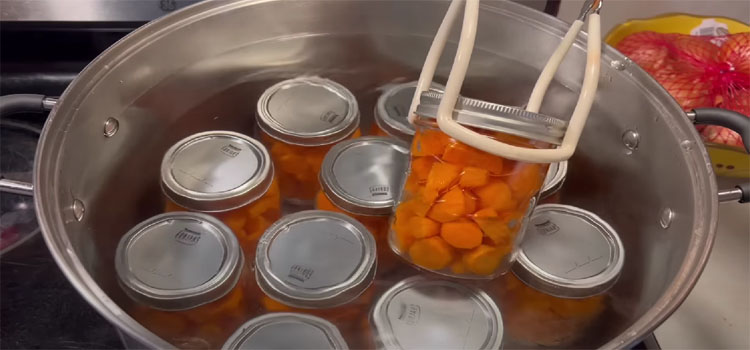Last Updated on September 15, 2024 by Shari Mason
Is food preservation possible without needing a pressure cooker? This question keeps popping up among folks looking to **keep food fresh** for longer.
As someone who cooks a lot, I understand why people are interested and want to try new ways.
Let’s look at the different ways and learn how you can start canning using different methods.
Is It Possible To Can Without A Pressure Cooker?


Yes, it is possible to can without a pressure cooker [1]. Alternative methods, such as water baths and steam canning, offer safe and effective options for preserving high-acid foods.
“Whether replacing one appliance that’s seen better days or many because you’re moving or renovating, you probably know to look for the Energy Star label. That’s good advice.”
– Jean Chatzky, American Journalist
These methods utilize simple techniques and readily available equipment, allowing you to enjoy the satisfaction of homemade preserves without needing a pressure cooker.
Related Posts:
- Should You Use Ninja Foodi For Canning?
- How Much Water Do You Put In A Pressure Canner?
- Should Jars Be Fully Submerged When Canning?
- Is Vacuum Sealing The Same As Canning?
- How To Wash Mason Jar Lids In Dishwasher?
What Are Some Alternative Canning Methods?
- Water Bath Canning:
- Water bath canning involves submerging filled jars in boiling water for a specific time.
- This method is suitable for high-acid foods like fruits, pickles, jams, and jellies, as the acidity helps inhibit bacterial growth.
- The heat from the boiling water creates a seal, preserving the food and extending its shelf life.
- Steam Canning:
- Steam canning is a relatively newer method that utilizes steam instead of water.
- With steam canning, jars are placed in a specialized steam canner or a large pot with a raised rack to keep the jars elevated.
- The steam generated creates the necessary heat for canning, achieving the same preservation results as water bath canning.
- This method is also suitable for high-acid foods.
- Refrigerator or Freezer Canning:
- Refrigerator or freezer canning is a short-term preservation method that doesn’t involve heat processing.
- Instead of sealing jars through heat, they are stored in the refrigerator or freezer to maintain freshness.
- This method is ideal for pickles, sauces, and quick-preserved items you intend to consume within a few weeks or months.
What Types Of Recipes Are Suitable For Alternative Canning Methods?
- Fruits: Using alternative canning methods, berries, peaches, apples, and other fruits can be transformed into delicious jams, jellies, or fruit preserves.
- Pickles and Relishes: Crisp cucumber pickles [2], zesty relishes, and tangy chutneys are excellent candidates for water baths or steam canning.
- Jams and Jellies: Classic strawberry jam, sweet blueberry preserves, or vibrant citrus marmalades can be easily preserved using alternative canning methods.
- Tomato-Based Products: Acidic tomato-based sauces, salsas, and marinara can be safely canned using these alternative methods.
Are There Any Limitations Or Considerations With Alternative Canning Methods?


- Acidic Foods Only:
- Alternative canning methods suit high-acid foods such as fruits, pickles, relishes, and acidic tomato-based products.
- Low-acid foods like vegetables, meat, and soups require high temperatures achieved by pressure canning for safe preservation.
- Safety Guidelines:
- Following reliable and up-to-date canning recipes and guidelines specific to your chosen alternative method is crucial.
- Proper procedures and processing times must be followed to ensure the safety and longevity of your preserved foods.
- Storage Duration:
- Canned foods preserved using alternative methods have a shorter shelf life than those processed using pressure canning.
- Consuming these preserved foods within a year is recommended for optimal quality and safety.
- Equipment:
- Water bath canning requires a large pot with a rack to submerge the jars, while steam canning requires a specialized steam canner or a raised rack.
- Ensure you have the necessary equipment in good condition for effective and safe canning.
- Cleanliness and Sterilization:
- Maintaining cleanliness and proper hygiene throughout the canning process is crucial.
- Jars, lids, and utensils should be thoroughly washed and sterilized to prevent contamination and ensure safe preservation.
“Explore the world of canning beyond the pressure cooker and unlock a realm of possibilities. With alternative methods at your disposal, you can confidently preserve the flavors of your harvest and embark on a canning journey that goes beyond tradition.”
– Eat Pallet Restaurant & Food Advice
FAQs
u003cstrongu003eIs it safe to can meat without a pressure canner?u003c/strongu003e
No, it is not safe to can meat without a pressure canner. Meat is a low-acid food that requires high temperatures achieved by pressure canning to ensure safety and prevent the growth of harmful bacteria. u003cbru003eu003cbru003eAlternative canning methods, such as water baths or steam canning, must be revised to preserve meat safely.
u003cstrongu003eIs pressure canning necessary?u003c/strongu003e
Pressure canning is necessary for safely preserving low-acid foods such as vegetables, meat, and soups. u003cbru003eu003cbru003eThe high temperatures reached in pressure canners ensure the elimination of harmful bacteria, making it essential for long-term shelf stability and food safety.
Key Takeaways
Canning without a pressure cooker is possible using alternative methods such as water baths and steam canning.
While pressure cookers are commonly associated with canning, these alternative techniques offer safe and effective options for preserving high-acid foods such as fruits, pickles, jams, and jellies.
It’s important to note that low-acid foods like vegetables and meat require high temperatures achieved by pressure canning for safe preservation.
By following reliable recipes and guidelines specific to each method, you can confidently embark on your canning journey and enjoy the satisfaction of homemade preserves.
References:
- https://www.thespruceeats.com/all-about-pressure-cookers-474755
- https://www.foodnetwork.com/recipes/rachael-ray/quick-pickles-recipe-1941519
- Can You Put an AC Unit in the Kitchen? - September 27, 2024
- What Cheese Does Olive Garden Use? Discover Their Signature - September 27, 2024
- How to Cancel a Pizza Hut Order? Quick & Easy Guide - September 24, 2024


